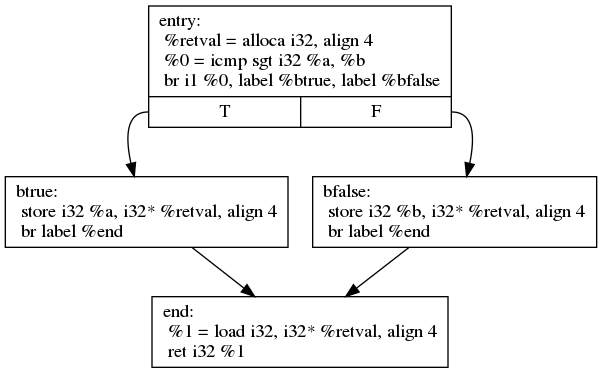Simple “if-then-else” Branching¶
First let’s take a look at a very simple function, that computes the maximum of two integers. This is implemented using a single if control statement.
int max(int a, int b) {
if (a > b) {
return a;
} else {
return b;
}
}
Remember that in LLVM IR control-flow is implemented by jumping between
basic blocks, which contain instruction sequences that do not change
control flow. Each basic block ends with an instruction that changes the
control flow. The most common branching instruction is
br [2]. br can be used conditionally, then it
implements a simple if-then-else, taking a boolean condition flag and
two basic block labels as parameter.
br i1 %cond, label %iftrue, label %iffalse
br can also be used to unconditionally jump to a certain destination:
br label %dest
define i32 @max(i32 %a, i32 %b) {
entry:
%retval = alloca i32, align 4
%0 = icmp sgt i32 %a, %b
br i1 %0, label %btrue, label %bfalse
btrue: ; preds = %2
store i32 %a, i32* %retval, align 4
br label %end
bfalse: ; preds = %2
store i32 %b, i32* %retval, align 4
br label %end
end: ; preds = %btrue, %bfalse
%1 = load i32, i32* %retval, align 4
ret i32 %1
}
In the example above, there are 4 basic blocks. The first one is the
function entry block. There space is allocated on the stack with
alloca [1], which acts as a temporary storage for the bigger value. Then
the two parameter %a and %b are compared using the
icmp instruction [3]. The result is a boolean
(i1) flag, which is then used as condition for the br
instruction. Then depending on the taken branch, either %a or %b
is stored into the temporary %retval variable. Each of the branches
then end with a unconditional branch to the last basic block %end.
There the value from %retval is loaded and returned.
You can get a graphical representation of the control-flow in the form
of a control-flow graph (CFG). This can be generated by using
opt -dot-cfg input.ll.

Control-Flow Graph of the max function
LLVM IR is a rather rich intermediate code format. So when compiling the
above snippet with higher optimization levels, LLVM will optimize the
code to use the select instruction [4] instead
of generating branches. The select instruction simply chooses
between two values, based on a boolean condition. This shortens the code
significantly.
define i32 @max(i32 %a, i32 %b) {
%1 = icmp sgt i32 %a, %b
%2 = select i1 %1, i32 %a, i32 %b
ret i32 %2
}
| [1] | LangRef: alloca |
| [2] | LangRef: br |
| [3] | LangRef: icmp |
| [4] | LangRef: select |